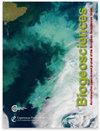Sources and sinks of carbonyl sulfide inferred from tower and mobile atmospheric observations in the Netherlands
IF 3.9
2区 地球科学
Q1 ECOLOGY
引用次数: 0
Abstract
Abstract. Carbonyl sulfide (COS) is a promising tracer for the estimation of terrestrial ecosystem gross primary production (GPP). However, understanding its non-GPP-related sources and sinks, e.g., anthropogenic sources and soil sources and sinks, is also critical to the success of the approach. Here we infer the regional sources and sinks of COS using continuous in situ mole fraction profile measurements of COS along the 60 m tall Lutjewad tower (1 m a.s.l.; 53∘24′ N, 6∘21′ E) in the Netherlands. To identify potential sources that caused the observed enhancements of COS mole fractions at Lutjewad, both discrete flask samples and in situ measurements in the province of Groningen were made from a mobile van using a quantum cascade laser spectrometer (QCLS). We also simulated the COS mole fractions at Lutjewad using the Stochastic Time-Inverted Lagrangian Transport (STILT) model combined with emission inventories and plant uptake fluxes. We determined the nighttime COS fluxes to be -3.0±2.6 pmol m−2 s−1 using the radon-tracer correlation approach and Lutjewad observations. Furthermore, we identified and quantified several COS sources, including biodigesters, sugar production facilities and silicon carbide production facilities in the province of Groningen. Moreover, the simulation results show that the observed COS enhancements can be partially explained by known industrial sources of COS and CS2, in particular from the Ruhr Valley (51.5∘ N, 7.2∘ E) and Antwerp (51.2∘ N, 4.4∘ E) areas. The contribution of likely missing anthropogenic sources of COS and CS2 in the inventory may be significant. The impact of the identified sources in the province of Groningen is estimated to be negligible in terms of the observed COS enhancements. However, in specific conditions, these sources may influence the measurements in Lutjewad. These results are valuable for improving our understanding of the sources and sinks of COS, contributing to the use of COS as a tracer for GPP.从荷兰的塔式和移动式大气观测推断出的羰基硫化物的来源和汇
摘要羰基硫(COS)是一种很有前途的估算陆地生态系统初级生产总值(GPP)的示踪剂。然而,了解其非GPP相关的源和汇,例如人为源和土壤源和汇对该方法的成功也至关重要。在这里,使用沿60 m高的Lutjewad塔(1 m a.s.l。;53∘24′ N、 6∘21′ E) 在荷兰。为了确定导致在Lutjewad观察到的COS分子组分增强的潜在来源,在格罗宁根省使用量子级联激光光谱仪(QCLS)从移动货车上进行了离散烧瓶样品和原位测量。我们还使用随机时间反演拉格朗日输运(STILT)模型,结合排放清单和植物吸收通量,模拟了COS摩尔分数Lutjewad。确定夜间COS通量为-3.0±2.6 pmol m−2 s−1。此外,我们确定并量化了几种COS来源,包括格罗宁根省的生物消化器、糖生产设施和碳化硅生产设施。此外,模拟结果表明,观测到的COS增强可以通过已知的COS和CS2的工业来源部分解释,特别是来自RuhrValley(51.5∘ N、 7.2 E) 和安特卫普(51.2∘ N、 4.4∘ E) 区域。清单中可能缺失的COS和CS2的人类成因来源的贡献可能很大。就观测到的COS增强而言,格罗宁根省已确定来源的影响估计是有利的。然而,在特定条件下,这些来源可能会影响卢杰瓦德的测量。这些结果有助于提高我们对COS来源和链接的理解,有助于将COS用作GPP的示踪剂。
本文章由计算机程序翻译,如有差异,请以英文原文为准。
求助全文
约1分钟内获得全文
求助全文
来源期刊

Biogeosciences
环境科学-地球科学综合
CiteScore
8.60
自引率
8.20%
发文量
258
审稿时长
4.2 months
期刊介绍:
Biogeosciences (BG) is an international scientific journal dedicated to the publication and discussion of research articles, short communications and review papers on all aspects of the interactions between the biological, chemical and physical processes in terrestrial or extraterrestrial life with the geosphere, hydrosphere and atmosphere. The objective of the journal is to cut across the boundaries of established sciences and achieve an interdisciplinary view of these interactions. Experimental, conceptual and modelling approaches are welcome.
 求助内容:
求助内容: 应助结果提醒方式:
应助结果提醒方式:


